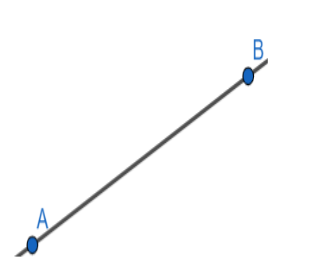
Answer
497.4k+ views
Hint: We can approach this question by first writing the equation of the straight line that passes through two points by using the two point formula and then substituting the other point in the line equation in order to get the relation given in the question.
Complete step-by-step answer:
Firstly, points which lie on the same straight line are called collinear points.
Now in order to check the collinearity we need to first find the equation of the straight line that passes through the two given points.
The equation of straight line passing through two points can be found by using the two point formula.

Let
\[\begin{align}
& A\left( {{x}_{1}},{{y}_{1}} \right) \\
& B\left( {{x}_{2}},{{y}_{2}} \right) \\
\end{align}\]
Now from two point formula equation of straight line passing through A and B is
\[\frac{x-{{x}_{1}}}{{{x}_{2}}-{{x}_{1}}}=\frac{y-{{y}_{1}}}{{{y}_{2}}-{{y}_{1}}}............\left( 1 \right)\]
Given points are (p,0), (0,q) now on comparing these with the points \[A\left( {{x}_{1}},{{y}_{1}} \right)\]and \[B\left( {{x}_{2}},{{y}_{2}} \right)\].
We get:
\[\begin{align}
& {{x}_{1}}=p,{{y}_{1}}=0 \\
& {{x}_{2}}=0,{{y}_{2}}=q \\
\end{align}\]
Now on substituting these values in the two point formula from the equation (1) we get,
\[\begin{align}
& \Rightarrow \dfrac{x-{{x}_{1}}}{{{x}_{2}}-{{x}_{1}}}=\dfrac{y-{{y}_{1}}}{{{y}_{2}}-{{y}_{1}}} \\
& \Rightarrow \dfrac{x-p}{0-p}=\dfrac{y-0}{q-0} \\
\end{align}\]
Now by simplifying it we get,
\[\Rightarrow \dfrac{x-p}{-p}=\dfrac{y}{q}\]
Now by simplifying the terms on both the sides we can write it as:
\[\Rightarrow \dfrac{-x}{p}+1=\dfrac{y}{q}\]
Then bring the x and y terms to one side and keep constant terms on the other side we get,
\[\Rightarrow \dfrac{x}{p}+\dfrac{y}{q}=1................\left( 2 \right)\]
Hence, the equation of line passing through (p,0) and (0,q) is \[\dfrac{x}{p}+\dfrac{y}{q}=1\].
Now as (p,0) and (0,q) and (1,1) are collinear that means they lie on the same straight line which implies that the point (1,1) lies on the line \[\dfrac{x}{p}+\dfrac{y}{q}=1.\]
A point is said to lie on the line when it satisfies the equation of the given line.
So, now by substituting (1,1) in the equation \[\dfrac{x}{p}+\dfrac{y}{q}=1.\]we get,
\[\therefore \dfrac{1}{p}+\dfrac{1}{q}=1\]
Hence option (b) is correct.
Note- The equation of the straight line can also be found by using the slope point method but here it is ideal to use the two point method because in the question they already gave all the points required to apply that formula. However, both the methods will give the same result.
While writing the equation of the line if we cross multiply it, it will be little confusing to reach to the conclusion of \[\dfrac{1}{p}+\dfrac{1}{q}\]. So, it is better to simplify by dividing it with p on the left hand side there itself.
Complete step-by-step answer:
Firstly, points which lie on the same straight line are called collinear points.
Now in order to check the collinearity we need to first find the equation of the straight line that passes through the two given points.
The equation of straight line passing through two points can be found by using the two point formula.

Let
\[\begin{align}
& A\left( {{x}_{1}},{{y}_{1}} \right) \\
& B\left( {{x}_{2}},{{y}_{2}} \right) \\
\end{align}\]
Now from two point formula equation of straight line passing through A and B is
\[\frac{x-{{x}_{1}}}{{{x}_{2}}-{{x}_{1}}}=\frac{y-{{y}_{1}}}{{{y}_{2}}-{{y}_{1}}}............\left( 1 \right)\]
Given points are (p,0), (0,q) now on comparing these with the points \[A\left( {{x}_{1}},{{y}_{1}} \right)\]and \[B\left( {{x}_{2}},{{y}_{2}} \right)\].
We get:
\[\begin{align}
& {{x}_{1}}=p,{{y}_{1}}=0 \\
& {{x}_{2}}=0,{{y}_{2}}=q \\
\end{align}\]
Now on substituting these values in the two point formula from the equation (1) we get,
\[\begin{align}
& \Rightarrow \dfrac{x-{{x}_{1}}}{{{x}_{2}}-{{x}_{1}}}=\dfrac{y-{{y}_{1}}}{{{y}_{2}}-{{y}_{1}}} \\
& \Rightarrow \dfrac{x-p}{0-p}=\dfrac{y-0}{q-0} \\
\end{align}\]
Now by simplifying it we get,
\[\Rightarrow \dfrac{x-p}{-p}=\dfrac{y}{q}\]
Now by simplifying the terms on both the sides we can write it as:
\[\Rightarrow \dfrac{-x}{p}+1=\dfrac{y}{q}\]
Then bring the x and y terms to one side and keep constant terms on the other side we get,
\[\Rightarrow \dfrac{x}{p}+\dfrac{y}{q}=1................\left( 2 \right)\]
Hence, the equation of line passing through (p,0) and (0,q) is \[\dfrac{x}{p}+\dfrac{y}{q}=1\].
Now as (p,0) and (0,q) and (1,1) are collinear that means they lie on the same straight line which implies that the point (1,1) lies on the line \[\dfrac{x}{p}+\dfrac{y}{q}=1.\]
A point is said to lie on the line when it satisfies the equation of the given line.
So, now by substituting (1,1) in the equation \[\dfrac{x}{p}+\dfrac{y}{q}=1.\]we get,
\[\therefore \dfrac{1}{p}+\dfrac{1}{q}=1\]
Hence option (b) is correct.
Note- The equation of the straight line can also be found by using the slope point method but here it is ideal to use the two point method because in the question they already gave all the points required to apply that formula. However, both the methods will give the same result.
While writing the equation of the line if we cross multiply it, it will be little confusing to reach to the conclusion of \[\dfrac{1}{p}+\dfrac{1}{q}\]. So, it is better to simplify by dividing it with p on the left hand side there itself.
Recently Updated Pages
10 Examples of Evaporation in Daily Life with Explanations

10 Examples of Diffusion in Everyday Life

1 g of dry green algae absorb 47 times 10 3 moles of class 11 chemistry CBSE

If the coordinates of the points A B and C be 443 23 class 10 maths JEE_Main

If the mean of the set of numbers x1x2xn is bar x then class 10 maths JEE_Main

What is the meaning of celestial class 10 social science CBSE

Trending doubts
Fill the blanks with the suitable prepositions 1 The class 9 english CBSE

Which are the Top 10 Largest Countries of the World?

How do you graph the function fx 4x class 9 maths CBSE

Differentiate between homogeneous and heterogeneous class 12 chemistry CBSE

Difference between Prokaryotic cell and Eukaryotic class 11 biology CBSE

Change the following sentences into negative and interrogative class 10 english CBSE

The Equation xxx + 2 is Satisfied when x is Equal to Class 10 Maths

In the tincture of iodine which is solute and solv class 11 chemistry CBSE

Why is there a time difference of about 5 hours between class 10 social science CBSE




